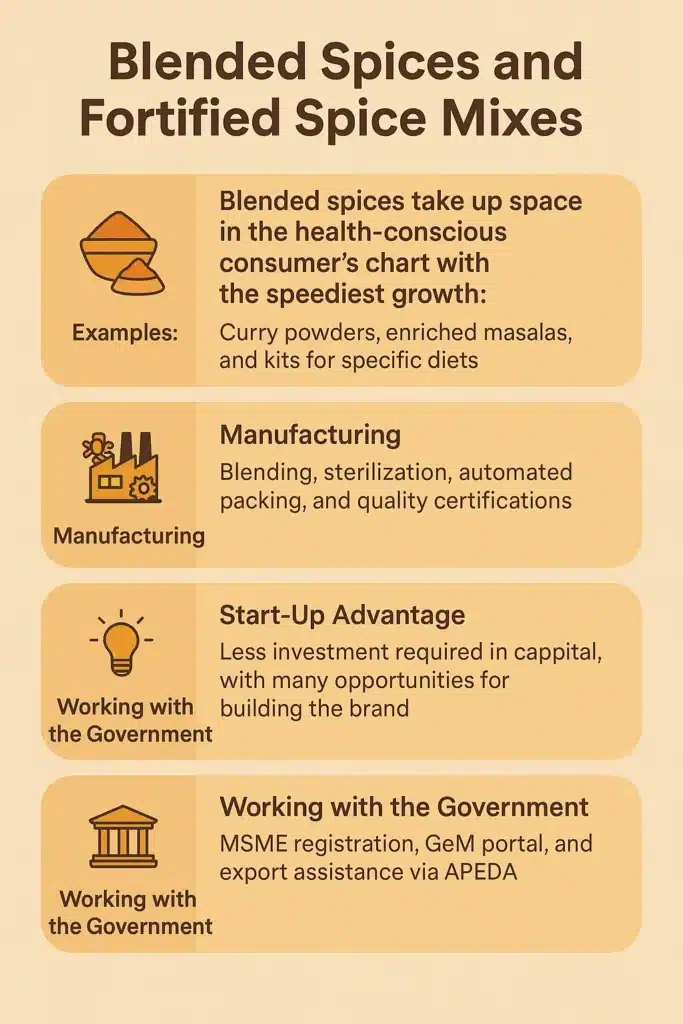India’s spice saga now goes beyond just exporting whole pepper, turmeric, or cumin. This exceeds ₹1.25 trillion in exports, and the Spice Annual Report of 2023-24 crowns India as a truly global leader regarding volume and value.
Moreover, it stands for hitherto untapped avenues in value-added manufacturing, where entrepreneurs can reap high margins, build global brands, and diversify India’s export portfolio.
Therefore, startups can move beyond bulk trading towards semi-processed and finished products and leverage the increased global demand for natural and standardized fortified spices.
India’s Landscape of Spice Exports
- Export volume: More than 15 million tonnes in 2023-24.
- Export value: ₹1.25 trillion with the leading drivers of exports: chili, turmeric, cumin, cardamom, celery, and pepper.
- Added-value share: Fast-growing with excellent future prospects for domestic manufacturing.
From here, indeed, value addition becomes an opportunity for startups to capture more margins and meet international market expectations.
Why Should Startups Have an Eye on Spices?
- High Margins: Derivatives, blends, and fortified give 25-40% margins, as against 5-10% for raw spices.
- Demand for Clean Labels: Global food, nutraceutical, and cosmetic industries are increasingly inclining towards natural extracts and standardized blends.
- Incentives from Government: The Ministry of Food Processing Industries (MoFPI), MSME, as well as Agricultural and Processed Food Products Export Development Authority (APEDA), provide a capital subsidy besides export support and technological upgrades.
- E-commerce Boom: The e-commerce medium allows small brand players entry to international markets at no cost for distribution.
The dual edge of startups emerges with the current trend and winning ways of profits maximization.
Read Our Project Report: Click Here
High Potential Sectors in Startups
Chilli, Turmeric and Pepper Oleoresins
Oleoresin concentrates flavor, color, and aroma, and are ideal for snacks, ready meals, sauces, and nutraceuticals.
- Manufacturing: Solvent extraction, evaporation, filtration, and standardization.
- Startups Benefit: Smaller losses from bulk export, longer shelf life, and much higher cost.
- Government Offer: help through APEDA in exporting.
- Both of them: North America and Europe demand natural colorants and functional ingredients.
Read More: Profitable Spice Blend Business Ideas for Entrepreneurs
Essential Oils (Cardamom, Clove, Celery)
Steam distilled oils are flavor enrichers for cosmetics and pharmaceuticals.
- Business Model: Small to medium steam distillation units.
- Supply Chain Efficiency: Converts oils from post-harvest waste, minimizing wastage.
- Government Assistance: Co-funding from PMKSY of MoFPI and MSME.
- Insight Into Export: Spice oils are nearly one-third item of spice export from India.

Blended Spices and Fortified Spice Mixes
Blended spices take up space in the health-conscious consumer’s chart with the speediest growth.
- Examples: Curry powders, enriched masalas, and kits for specific diets.
- Manufacturing: Blending, sterilization, automated packing, and quality certifications.
- Start-Up Advantage: Less investment required in capital, with many opportunities for building the brand.
- Working with the Government: MSME registration, GeM portal, and export assistance via APEDA.
Read Our Book: Click Here
Encapsulation of Spice Flavors
Encapsulation helps in stabilizing extracts and converting them to instant powder products for use in foods and beverages.
- Manufacturing: Spray drying or microencapsulation with carrier agents.
- Startup Edge: B2B supplied or D2C brands launched.
- Government Assistance: R&D funded by MoFPI and the DST incubator for technology adoption.
Mixes for Gourmet and Organic Uses
Organic blends fetch a premium due to health consciousness, increasing rapidly.
- Examples: Smoky rubs, masalas infused with truffle, international spice kits.
- Market Access: E-commerce, specialty stores, or export to premium retail chains.
- Certifications: IndGAP, Organic, FSSAI International credibility ensured.
How NPCS Can Help You
Niir Project Consultancy Services (NPCS) extends many support facilities to starting business ventures aimed at converting business ideas on spices into profitable business operations.
Firstly, they carry out detailed market surveys and prepare detailed techno-economic feasibility reports (DPRs) covering manufacturing processes and product mix capacity planning, raw material sourcing, machinery requirements, financial projections, and profitability analysis.
Furthermore, NPCS provides market and demand insight services that equip entrepreneurs with the capability to minimize risk and access government incentives in making product selection and scaling of the actual business model in the rapidly growing spice export sector in India.
Read More: How to Build a Sustainable Spice Business with Indian Crops
MSMEs Success Stories
- Kerala Oleoresin Units: Contract processors are supplying nutraceutical and flavoring brands now.
- Gujarat Blenders: From bulk masalas to custom exports for global QSR chains.
- Rajasthan Organic Farms: Certified organic-fortified products with shelf space in premium Europe.
Lesson: Start small with contract manufacturing, built expertise, and scale area gradually into branded products for global markets.
Import-Export Insights for Start-Ups
Number one on the list is the chilli, turmeric, cumin, celery, and pepper exportation from India, where value-added oils and oleoresins quickly emerge as favorites in the fast lane.
Startup Strategy:
- Find spices that are highly demanded with high volumes.
- Extract, blend, or fortify for added value.
- Imports may either have thick concentrates or seasonings or else be a niche.
North America, Europe, Middle East, and East Asia will be focused. They are the rising consumer market for functional and natural foods.
Action Plan for New Entrepreneurs
- Feasibility analysis: Selection of derivatives or blends suitable with the capital and location through NPCS.
- Government policies: Use of PMKSY, MSME Technology Support, and APEDA for Export Assistance.
- Supply Chain: Enter a correlation with various FPOs for consistent raw materials supply.
- Certifications: FSSAI and IndGAP and Organic for going into the export-ready list.
- Branding & Distribution: Use e-commerce, global distributors, and exhibitions for an effective and reach growing platform.
Future Trends
- Functional Fortification: Turmeric combined with probiotics or immunity boosters.
- Clean Label Ready Meals: Pre-mixed spice kits that cater to healthy plant-based consumers or consumers attentive to healthy eating.
- Tech-enabled Traceability: Blockchain and QR codes for proof of verification of spice origin and quality.
Find the Best Idea for Yourself With our Startup Selector Tool
Conclusion: Turning Spices into Startup Wealth
What India exports is more than just numbers; it amounts to a roadmap for those aspiring to become entrepreneurs. Indian spice startup businesses can go from raw spices to derivatives, blends, and fortified products.
In this way, it will generate premium margins, build global Brands, and strengthen India’s position as an export leader. Incentives from the government, robust supply chains, NPCS mode to turn the rich legacy of the spices of India into a modern industrial success, “Spices to Startup Gold.”
FAQs
Which spices are most exported profitably?
Chili, turmeric, cumin, cardamom, celery, and pepper.
What high-margin value-added products are there?
Oleoresins, essential oils, blended masalas, encapsulated flavors, and organic spice kits.
Which government schemes are in place for spice startups?
PMKSY, MSME technology upgradation, and APEDA export assistance.
How can NPCS help newcomers in business?
They are the Lenders of DPRs, feasibility studies, market intelligence, and production know-how.
Which are the markets with the maximum growth potential?
North America, Europe, Middle East, and East Asia for natural and functional spices.







